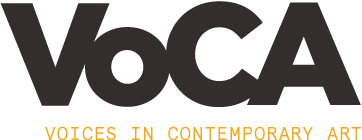Editor’s Note
Timed to coincide with VoCA’s inaugural Time-based Media (TBM) Stewardship Workshops, this issue of VoCA Journal focuses on the complexities of collecting, presenting, and caring for media art. As a conservator working in the contemporary sphere, and a long-standing VoCA Board member, I have witnessed artists continually incorporate cutting-edge technologies into their creative practices. In response, open and collaborative dialogues among stakeholders from a variety of backgrounds have been necessary to keep the field of preservation in a perpetual state of adaptation.
A conversation between Eddy Colloton, TBM conservator at the Hirshhorn, and Elena Cordova, Project Director at Maintenance Culture, introduces the challenges encountered by small to mid-sized collecting institutions and those who are not digital preservation experts. Their discussion is overwhelmingly encouraging, and sets the tone for the issue as a whole. By focusing on the context of the artwork, breaking down projects into digestible steps, and joining a community of professionals with diverse skillsets, anyone with a passion for media art can overcome the hurdles of caring for these works, even if there are a few stumbles along the way.
Marshall Reese, an artist and recurring contributor to the VoCA Blog, spoke with Don Fleming, Jonathan Haim, and Kevin Parks about the acquisition of musician and songwriter Lou Reed’s archive into the New York Public Library (NYPL)’s Performing Arts Library Collection. With 50 years of media formats represented in the archive, a year of media transfers done in collaboration with the musician’s assistants was just the first step towards the ultimate goal of making the archive widely accessible to the public. The subsequent multimedia exhibition Lou Reed: Caught Between the Twisted Stars pulled from the archive, and the digital finding aid for the collection pushed boundaries in its capacity to directly link to playable audio and video files.
Lia Robinson, the former Director of Programs and Research at the Shigeko Kubota Video Art Foundation (SKVAF), writes about Two-Way LA-NYC Video Phone, an experiment that explored the non-commercial potential of video phone technology in 1979. The transcontinental call, initiated by Mitsuru Kataoka, an artist and professor at the University of California, Los Angeles (UCLA), linked to fellow artists Shigeko Kubota and Nam June Paik. Though the resources of an artist-endowed foundation may be limited, SKVAF’s direct connection to the artists make the organization well positioned to maintain and provide access to materials outside of the purview of larger institutions. Community building and a collaborative approach can enable primary sources, like the event-based experimental video call, to be saved from the threat of technical obsolescence.
Nicole Christiane Savoy, Ralph Michel, and Marie-Christine Gerber, studying under Martina Haidvogl at Bern Academy of the Art, detail the preservation of the participatory web-based artwork Learning To Love You More, by Harrell Fletcher and Miranda July. The work in SFMOMA’s collection served to test two preservation strategies: migration and emulation. Rhizome, a nonprofit that champions and provides a platform for born-digital art, used the work to test its platform’s infrastructure. The pooling of resources from all three institutions allowed for in-depth research that advanced the field of net art conservation.
Each of the authors that contributed to this issue exemplify the enthusiasm and passion for time-based media art that is so often the driving force in its preservation. Our contributors are not all established preservation professionals, but rather they are emerging conservators and curators; a program director at an artist foundation; and an artist working in new technologies. Their varied backgrounds bring unique perspectives and great insights to the inherently collaborative field of media preservation.
– Steven O’Banion


